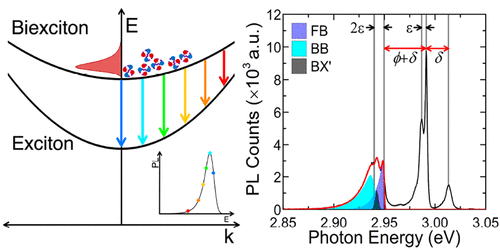当前位置:
X-MOL 学术
›
J. Am. Chem. Soc.
›
论文详情
Our official English website, www.x-mol.net, welcomes your
feedback! (Note: you will need to create a separate account there.)
Impact of Dark Excitons on the Population and Relaxation Kinetics of Two-Dimensional Biexcitons in [CH3(CH2)3NH3]2Pb1–xMnxBr4 (x = 0–0.09)
Journal of the American Chemical Society ( IF 14.4 ) Pub Date : 2021-11-18 , DOI: 10.1021/jacs.1c08474 Wonkyung Choi 1 , Seo Hyun Nam 1 , Hyeon-Kyeong So 1 , Sang-Eon Lee 1 , Myung-Hwa Jung 1 , Joon I Jang 1
Journal of the American Chemical Society ( IF 14.4 ) Pub Date : 2021-11-18 , DOI: 10.1021/jacs.1c08474 Wonkyung Choi 1 , Seo Hyun Nam 1 , Hyeon-Kyeong So 1 , Sang-Eon Lee 1 , Myung-Hwa Jung 1 , Joon I Jang 1
Affiliation

|
Two-dimensional (2D) semiconductors have emerged as an excellent platform for studying various excitonic matter under strong quantum and dielectric confinements. However, such effects can be seriously overestimated for Coulomb binding of two excitons to form a biexciton by a naive interpretation of the corresponding photoluminescence (PL) spectrum. By using 2D halide perovskite single crystals of [CH3(CH2)3NH3]2Pb1–xMnxBr4 (x = 0–0.09) as a model system, we investigated both population and relaxation kinetics of biexcitons as a function of excitation density, temperature, polarization, and Mn doping. We show that the biexciton is formed by binding of two dark excitons, which are partially bright, but they radiatively recombine to yield a bright exciton in the final state. This renders the spectral distance between the exciton peak and the biexciton peak as very different from the actual biexciton binding energy (ϕ) because of large bright–dark splitting. We show that Mn doping introduces paramagnetism to our 2D system and improves the biexciton stability as evidenced by increase in ϕ from 18.8 ± 0.7 to 20.0 ± 0.7 meV and the increase of the exciton–exciton capture coefficient C from 2.4 × 10–11 to 4.3 × 10–11cm2/ns within our doping range. The precisely determined ϕ values are significantly smaller than the previously reported ones, but they are consistent with the instability of the biexciton against thermal dissociation at room temperature. Our results demonstrate that electron–hole exchange interaction must be considered for precisely locating the biexciton level; therefore, the ϕ values should be reassessed for other 2D halide perovskites that even do not exhibit any dark exciton PL.
中文翻译:

暗激子对 [CH3(CH2)3NH3]2Pb1–xMnxBr4 (x = 0–0.09) 中二维双激子的布居和弛豫动力学的影响
二维 (2D) 半导体已成为研究强量子和介电限制下的各种激子物质的绝佳平台。然而,通过对相应光致发光 (PL) 光谱的幼稚解释,对于两个激子的库仑结合形成双激子,这种效应可能被严重高估。通过使用 [CH 3 (CH 2 ) 3 NH 3 ] 2 Pb 1– x Mn x Br 4 ( x= 0–0.09) 作为模型系统,我们研究了双激子的布居和弛豫动力学作为激发密度、温度、极化和 Mn 掺杂的函数。我们表明双激子是由两个暗激子结合形成的,这些暗激子是部分亮的,但它们在最终状态下通过辐射重组产生亮激子。由于大的明暗分裂,这使得激子峰和双激子峰之间的光谱距离与实际双激子结合能 (φ) 非常不同。我们表明,Mn 掺杂为我们的 2D 系统引入了顺磁性,并提高了双激子的稳定性,这可以通过 ϕ 从 18.8 ± 0.7 增加到 20.0 ± 0.7 meV 以及激子-激子捕获系数C从 2.4 × 10 –11增加来证明在我们的掺杂范围内达到 4.3 × 10 –11 cm 2 /ns。精确确定的 ϕ 值明显小于先前报道的值,但它们与双激子在室温下对热解离的不稳定性一致。我们的结果表明,必须考虑电子-空穴交换相互作用才能精确定位双激子能级;因此,对于其他甚至不表现出任何暗激子 PL 的二维卤化物钙钛矿,应该重新评估 ϕ 值。
更新日期:2021-12-01
中文翻译:

暗激子对 [CH3(CH2)3NH3]2Pb1–xMnxBr4 (x = 0–0.09) 中二维双激子的布居和弛豫动力学的影响
二维 (2D) 半导体已成为研究强量子和介电限制下的各种激子物质的绝佳平台。然而,通过对相应光致发光 (PL) 光谱的幼稚解释,对于两个激子的库仑结合形成双激子,这种效应可能被严重高估。通过使用 [CH 3 (CH 2 ) 3 NH 3 ] 2 Pb 1– x Mn x Br 4 ( x= 0–0.09) 作为模型系统,我们研究了双激子的布居和弛豫动力学作为激发密度、温度、极化和 Mn 掺杂的函数。我们表明双激子是由两个暗激子结合形成的,这些暗激子是部分亮的,但它们在最终状态下通过辐射重组产生亮激子。由于大的明暗分裂,这使得激子峰和双激子峰之间的光谱距离与实际双激子结合能 (φ) 非常不同。我们表明,Mn 掺杂为我们的 2D 系统引入了顺磁性,并提高了双激子的稳定性,这可以通过 ϕ 从 18.8 ± 0.7 增加到 20.0 ± 0.7 meV 以及激子-激子捕获系数C从 2.4 × 10 –11增加来证明在我们的掺杂范围内达到 4.3 × 10 –11 cm 2 /ns。精确确定的 ϕ 值明显小于先前报道的值,但它们与双激子在室温下对热解离的不稳定性一致。我们的结果表明,必须考虑电子-空穴交换相互作用才能精确定位双激子能级;因此,对于其他甚至不表现出任何暗激子 PL 的二维卤化物钙钛矿,应该重新评估 ϕ 值。










































 京公网安备 11010802027423号
京公网安备 11010802027423号